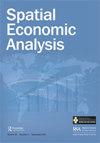On the geography of inequality: labour sorting in general equilibrium
IF 2.2
3区 经济学
Q2 ECONOMICS
引用次数: 0
Abstract
ABSTRACTWe study how cities’ amenities and limited housing supply contribute to aggregate wage inequality and affect housing prices through the sorting of heterogeneous skilled workers. We develop a general equilibrium model where workers differ along a continuum of skills and compete for limited housing. Our analysis suggests that spatial sorting accounts for 7.5% of the aggregate wage dispersion, increases average housing prices by 20–40% in constrained cities, and makes the economy 1.9% more productive. In addition, we evaluate a place-based policy that aims to expand the supply of houses in 1% of constrained cities and find that it improves aggregate productivity between 0.2% and 0.4%. However, the place-based policy has the unintended consequence of aggravating aggregate wage inequality by the same magnitude.KEYWORDS: labour sortinginequalityhousingplace-based policiesJEL: D44D58F16J24R13 ACKNOWLEDGEMENTSWe are extremely grateful to Ernesto Dal Bó, William Fuchs and John Morgan for their support. We also thank Scott Baker, Victor Couture, Cecile Gaubert, Rui de Figueiredo, William Grieser, William Hardin, Enrico Moretti, Gonzalo Maturana, Steve Tadelis, Joachim Voth, Reed Walker, Zhonghua Wu and Noam Yuchtman, as well as numerous seminar and conference participants, for their helpful discussions and comments. We would also like to thank Diogo Duarte who contributed to this project on an earlier version. This paper was originally part of Santiago Truffa’s PhD dissertation titled ‘Essays in urban economics’.DISCLOSURE STATEMENTNo potential conflict of interest was reported by the authors.Notes1 In this study we will focus on wage and housing price inequality. In particular, since we are able to compute wages at the individual level, we can analyse both between- and within-city inequality. When we refer to aggregate inequality, we mean the total variance of all individual wages.2 Shapiro (Citation200Citation6), Glaeser and Gottlieb (Citation2008), Couture (Citation2015), Albouy et al. (Citation2016) and Albouy (Citation2016) have empirically shown the importance of amenities in accounting for sorting patterns. We build on this literature, and we quantify the trade-off between amenities versus restrictions on the housing supply. Related literature has explored the sorting of heterogeneous firms (Behrens et al., Citation2014; Gaubert, Citation2018; Serrato & Zidar, Citation2016) to study the welfare implications of taxes and firm incentives. We complement this literature by focusing on the worker side. Further work is required to join these two threads in the literature.3 Frameworks that divide the workforce into discrete categories are empirically sensitive since the results depend on dichotomous definitions of what type of worker qualifies for each type of category. Indeed, Baum-Snow et al. (Citation2018) show that if we change the definition of high-skilled worker to a worker with some college education, some of the results shown by Diamond (Citation2016) no longer hold.4 To do so, we follow recent literature that models the housing market with bidding wars. For a review, see Han and Strange (Citation2015).5 A notable exception is Kline and Moretti (Citation2014), who develop a methodology to estimate their aggregate effects.6 Similar to Costinot and Vogel (Citation2010), we assume that Ai(s,σ)>0 is twice differentiable and strictly log-supermodular to capture the idea that high-skill workers have a comparative advantage in more complex tasks. This feature partially compensates for the fact that we have a common agglomeration elasticity and do not differentiate between low- and high-skilled workers’ elasticities.7 Notice that Li(s,σ)=vi(s)1{Mi(s)=σ}, where 1 is an indicator function. Also, notice that Bi=Vi(s¯).8 Following Albrecht et al. (Citation2016), we assume that Bi and Si are large enough so that the arrival rate of buyers visiting a particular seller follows a continuous Poisson process with parameter θi.10 The preference in (9) is a monotonic transformation of the homothetic preference U=Tailog(xi) commonly adopted in the literature. Thus, all the properties of this utility representation are preserved under the monotonic transformation in (9).11 In fact, this is consistent with empirical distributions of talent, as shown by Bacolod et al. (Citation2009). Although we see differences between cities in the fraction of high- to low-skilled workers, we still observe a positive mass of workers at every level of talent. Moreover, if we restrict attention to two cities, we can prove that for any pair of non-overlapping skill distributions, this configuration is never in equilibrium, since the lowest-skilled worker in the high-skilled city will always have an incentive to move to the low-skilled city, where she is the most skilled worker. We present the two cities case in the Appendix in the supplemental data online.12 The author develops a methodology that derives hedonic measures of local productivity and local amenities from data, such as local wages, housing prices and taxes. The quality-of-life measure positively correlates to measures of natural amenities relating to climate and geography.13 This measure stems from satellite-generated data on terrain elevation and the presence of water bodies to estimate the amount of developable land in each MSA. We focus on the part of the elasticity that is determined by geographical restrictions.论不平等的地理:一般均衡中的劳动分类
摘要本文通过对异质技术工人的分类,研究了城市的便利设施和有限的住房供应如何导致总工资不平等并影响房价。我们开发了一个一般均衡模型,其中工人在连续的技能上存在差异,并为有限的住房而竞争。我们的分析表明,空间分类占总工资差异的7.5%,在受限制的城市中,平均房价上涨了20-40%,并使经济生产力提高了1.9%。此外,我们评估了一项基于地方的政策,该政策旨在扩大1%受限城市的住房供应,并发现它提高了0.2%至0.4%的总生产率。然而,基于地点的政策产生了意想不到的后果,即在同样程度上加剧了总体工资不平等。关键词:劳动分类不平等住房基于地方的政策我们非常感谢Ernesto Dal Bó, William Fuchs和John Morgan的支持。我们还要感谢Scott Baker、Victor Couture、Cecile Gaubert、Rui de Figueiredo、William Grieser、William Hardin、Enrico Moretti、Gonzalo Maturana、Steve Tadelis、Joachim Voth、Reed Walker、Zhonghua Wu和Noam Yuchtman以及众多研讨会和会议参与者的宝贵讨论和意见。我们还要感谢Diogo Duarte,他为这个项目的早期版本做出了贡献。这篇论文最初是圣地亚哥·特鲁法博士论文《城市经济学论文》的一部分。声明作者未报告潜在的利益冲突。注1在本研究中,我们将关注工资和房价不平等。特别是,由于我们能够计算个人水平的工资,我们可以分析城市之间和城市内部的不平等。当我们提到总体不平等时,我们指的是所有个体工资的总方差Shapiro (Citation200Citation6)、Glaeser和Gottlieb (Citation2008)、Couture (Citation2015)、Albouy等人(Citation2016)和Albouy (Citation2016)已经从经验上证明了舒适度对分类模式的重要性。我们以这些文献为基础,量化了便利设施与住房供应限制之间的权衡。相关文献探讨了异质性企业的分类(Behrens et al., Citation2014;•高柏,Citation2018;Serrato & Zidar, Citation2016)研究税收和企业激励对福利的影响。我们通过关注工人方面来补充这些文献。需要进一步的工作来连接这两个线程在文献中将劳动力划分为离散类别的框架在经验上是敏感的,因为结果依赖于哪种类型的工人符合每种类别的二分定义。事实上,Baum-Snow等人(Citation2018)表明,如果我们将高技能工人的定义更改为具有大学学历的工人,Diamond (Citation2016)所显示的一些结果将不再成立为了做到这一点,我们参考了最近用竞标战来模拟房地产市场的文献。详见《汉与奇》(Citation2015)一个值得注意的例外是Kline和Moretti (Citation2014),他们开发了一种方法来估计他们的总体效应与Costinot和Vogel (Citation2010)类似,我们假设Ai(s,σ)>0是二次可微且严格对数超模的,以捕捉高技能工人在更复杂的任务中具有比较优势的想法。这一特征部分补偿了我们有一个共同的集聚弹性和不区分低技能和高技能工人的弹性的事实注意,Li(s,σ)=vi(s)1{Mi(s)=σ},其中1是一个指示函数。另外,请注意Bi=Vi(s¯)根据Albrecht等人(Citation2016)的假设,我们假设Bi和Si足够大,使得访问特定卖家的买家到达率遵循参数为θi.10的连续泊松过程(9)中的偏好是文献中常用的齐次偏好U=Tailog (xi)的单调变换。因此,在式(9).11的单调变换下,该效用表示的所有性质都保持不变事实上,这与Bacolod等人(Citation2009)所显示的人才的实证分布是一致的。尽管我们看到不同城市在高技能工人和低技能工人的比例上存在差异,但我们仍然观察到,在各个水平的人才中,工人的数量都是正的。此外,如果我们将注意力限制在两个城市,我们可以证明,对于任何一对不重叠的技能分布,这种配置永远不会处于均衡状态,因为高技能城市中技能最低的工人总是有动机搬到技能最高的低技能城市。我们在网上补充资料的附录中介绍了这两个城市的病例。
本文章由计算机程序翻译,如有差异,请以英文原文为准。
求助全文
约1分钟内获得全文
求助全文
来源期刊

Spatial Economic Analysis
ECONOMICS-
CiteScore
5.40
自引率
21.70%
发文量
33
期刊介绍:
Spatial Economic Analysis is a pioneering economics journal dedicated to the development of theory and methods in spatial economics, published by two of the world"s leading learned societies in the analysis of spatial economics, the Regional Studies Association and the British and Irish Section of the Regional Science Association International. A spatial perspective has become increasingly relevant to our understanding of economic phenomena, both on the global scale and at the scale of cities and regions. The growth in international trade, the opening up of emerging markets, the restructuring of the world economy along regional lines, and overall strategic and political significance of globalization, have re-emphasised the importance of geographical analysis.
 求助内容:
求助内容: 应助结果提醒方式:
应助结果提醒方式:


